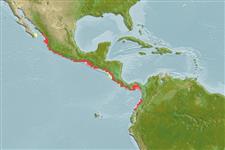Classification / Names
Common names | Synonyms | Catalog of Fishes (gen., sp.) | ITIS | CoL | WoRMS | Cloffa
Actinopterygii (ray-finned fishes) >
Siluriformes (Catfish) >
Ariidae (Sea catfishes) > Ariinae
Etymology: Occidentarius: Name Latin 'occidens' meaning west, and the genus name Arius; in reference to the restriction of the species to the EP, the western-most region occupied by ariids..
Environment / Climate / Range
Ecology
Marine; brackish; demersal; depth range 6 - 107 m (Ref. 96339), usually ? - 60 m (Ref. 9271). Tropical, preferred ?; 24°N - 1°N
Eastern Pacific: México to Perú.
Size / Weight / Age
Maturity: Lm ? range ? - ? cm
Max length : 50.0 cm TL male/unsexed; (Ref. 96339); common length : 25.0 cm TL male/unsexed; (Ref. 55763)
Diagnosis: This species is distinguished by the following characters: anterior cavities of lateral ethmoids (where the olfactory bulb is housed) greatly developed; bony excrescence of posterolateral process of lateral ethmoids prominent, completely closing the lateral fenestrae; basioccipital with a laminar bony crest bordering the anterior foramen of aortic tunnel (Ref. 86580).
Abundant on the continental shelf (Ref. 9271). Utilized fresh or salted, but rarely consumed (Ref. 9271). Demersal species that inhabits sandy substrates in coastal waters up to 60m deep. May be caught in nets and purse seines along with other fishes. It is sold fresh (Ref. 55763).
Life cycle and mating behavior
Maturity | Reproduction | Spawning | Eggs | Fecundity | Larvae
Betancur-R, R., A. Acero P, E. Bermingham and R. Cooke, 2007. Systematics and biogeography of New World sea catfishes (Siluriformes: Ariidae) as inferred from mitochondrial, nuclear, and morphological evidence. Mol. Phylogen. Evol. 45:339-357. (Ref. 86580)
IUCN Red List Status (Ref. 115185)
CITES (Ref. 94142)
Not Evaluated
Threat to humans
Traumatogenic (Ref. 58010)
Human uses
Fisheries: minor commercial
More information
Common namesSynonymsMetabolismPredatorsEcotoxicologyReproductionMaturitySpawningFecundityEggsEgg development
ReferencesAquacultureAquaculture profileStrainsGeneticsAllele frequenciesHeritabilityDiseasesProcessingMass conversion
Tools
Special reports
Download XML
Internet sources
